
Why Interest Rate Cuts May Not Be A Cure-All For What Ails CRE Lending
As investors anxiously await the Federal Reserve's decision next week, a cloud of uncertainty hangs over the financial markets. Fund strategists, investment firm leaders, and bank executives are bracing for an economic slowdown—if not an outright recession. The commercial real estate sector, in particular, is pinning its hopes on a rate cut to unlock credit markets. However, lenders are more focused on strengthening their own balance sheets than underwriting new debt.
During Fort Lauderdale-based Optimum Bank’s Virtual Banking Conference on Thursday morning, a dozen financial insiders gathered to share their perspectives on investment strategies. The mood was palpable: uncertainty, anxiety, and pessimism about the U.S. financial system permeated the discussions.
"Traditional lenders should be cautious about adding their voices to the Wall Street clamor for big cuts," warned Sheila Bair, former chair of the Federal Deposit Insurance Corp. "To be sure, those who have unrealized losses on their securities portfolios will see a nice boost in the value of those assets, but their core business could be challenged if the Fed goes too fast."
Bair's caution reflects a broader concern among financial experts. Capital underwriting for commercial real estate could loosen if the Fed follows through on consensus plans for rate cuts, but these cuts won't occur in a vacuum. There remains a real possibility of broader macroeconomic headwinds, ranging from a weaker dollar to a negative turn in labor markets. Banks have, in turn, continued to shore up reserves.
Approximately $1 trillion in commercial real estate debt is slated to mature in the next year. Banks wrestling with uncertainty in other sectors, while facing increased scrutiny from federal regulators, may not rush to open their commercial lending books to fill that gap.
"As that paper is coming due, we're seeing tremendous scrutiny from the regulators in the investment community, and you're seeing loan growth there really slow," said Nathan Stovall, director of research at S&P Global Market Intelligence’s financial institution group.
The looming wall of maturities in the commercial real estate market continues to grow as sponsors take short-term extensions, bridge loans, or find other ways to delay refinancing at today's rates. Most of what's coming due are five-year balloon mortgages originated between 2018 and 2020 when carrying rates were around 3%, explained Rebel Cole, a professor of finance at Florida Atlantic University.
"The best those sponsors can hope for in the short term is to refinance at between 7% and 10%," Cole said. "It doesn't matter if you're in Florida, it doesn't matter if you're an industrial property, it doesn't matter if you're 100% leased. When that mortgage goes from 300 basis points to 800 basis points, that property is most likely going to foreclosure."
The National Federation of Independent Business’ Small Business Uncertainty Index stands at 92, its highest level since October 2020, with 24% of owners continuing to report that inflation is their top concern. That uncertainty, coupled with other weak economic indicators, is "screaming that we're headed towards a recession," Cole added.
While not every panelist was ready to predict an outright downturn, none expressed optimism around near-term economic growth. Most suggested that a period of persistent low growth likely lies ahead, largely due to the deficit spending that has dominated U.S. budgets for over a decade.
"The consensus projection is 25 basis points next week, with two more 25 basis point cuts before the end of the year," Bair noted. "I think 75 basis points total by the end of this year is likely, but I will take a wait-and-see posture on further cuts next year, mainly because I think the continuation of fiscal inflationary pressures will increase, and that's regardless of who is elected president."
However, she and other economists have argued that it's still too early to cut rates. Numbers released Wednesday show annual inflation slid to 2.6%, the lowest level since February 2021, and recent jobs report data has been weak. But the Fed has signaled for over a year that its target inflation rate is 2.0%, suggesting there is still work to be done.
The counterargument is that topline numbers fail to capture weaknesses—like lower spending for low-income earners or the shift of labor from full-time to part-time positions—that signal it's time to cut rates. A failure to move now, and perhaps with haste, could lock the economy into a recession, panelists said.
Expectations are that Fed Chair Jerome Powell is aligned with the monetary doves for the first time since the Fed began raising rates, and that the likely first cut would signal many more to come, helping to unjam the capital markets.
"I am concerned about the next six to twelve months, and I think businesses have to be ready for that," said Gareth Soloway, the chief market strategist at Verified Investing. Delinquency rates continue to rise, and "these are little breadcrumbs that are showing that things are changing; they're just not at that break point yet," he added.
Bair offered a word of caution for lenders eager for a Fed pivot. "With big rate cuts, your loan yields may well go down, but you will still face significant competitive pressure on the rates you have to pay on deposits," she said.
The commercial real estate sector's hopes for a rate cut unlocking credit markets may be overly optimistic. Lenders, facing regulatory scrutiny and economic uncertainty, may not be willing or able to extend new credit. As a result, the sector could face significant challenges in refinancing the massive debt coming due.
In the midst of this financial tightrope, businesses and investors are left to navigate an unpredictable landscape. Whether the Fed's next move will stabilize the economy or hasten a downturn remains a pressing question.